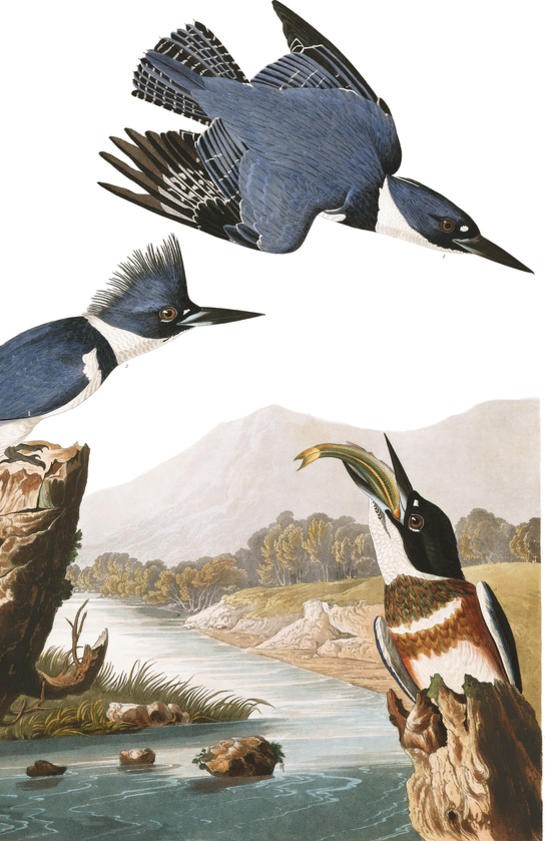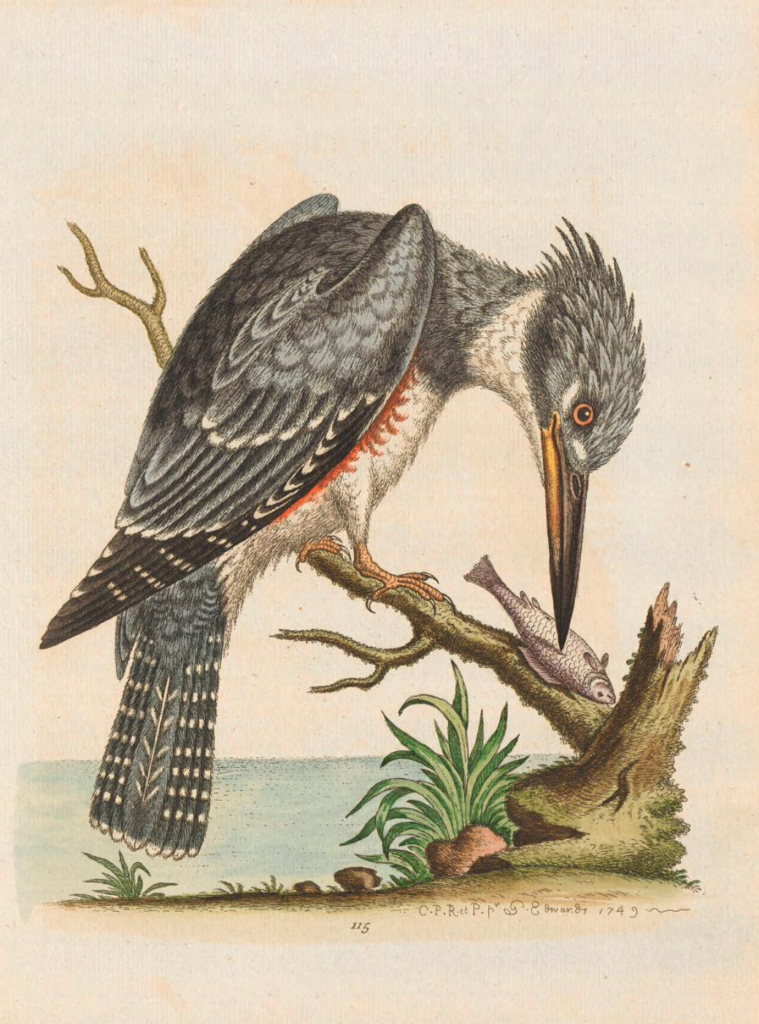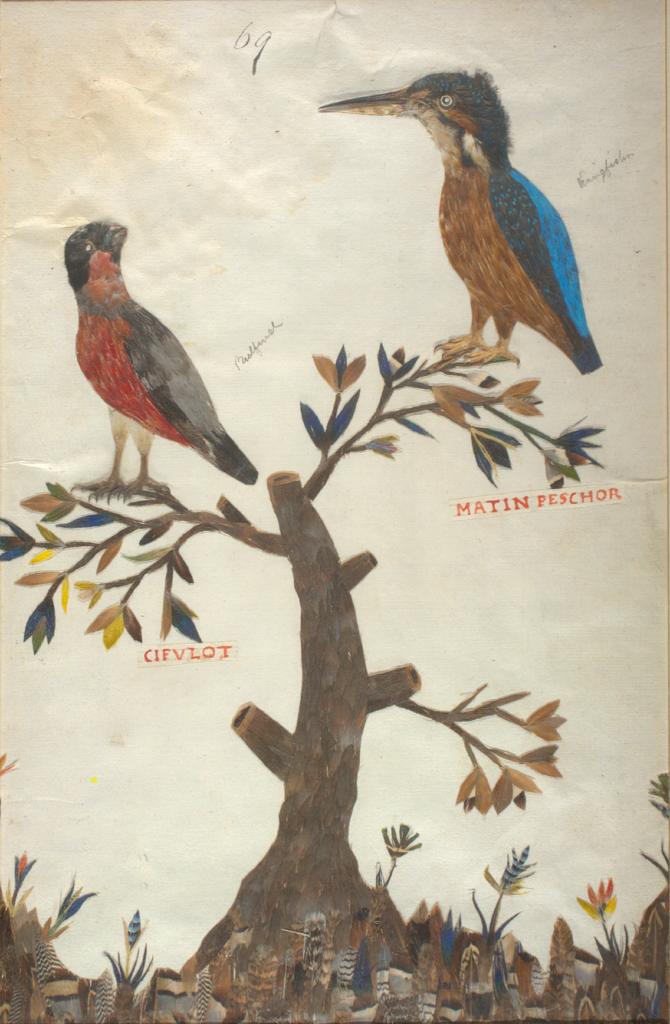By Rick Wright
John James Audubon is famous for the gridded scaffolding he invented to mount the models for his paintings:

“I pierced the body of the fishing bird [Belted Kingfisher] and fixed it on the board; another wire passed above his upper mandible held the head in a pretty fair attitude, smaller ones fixed the feet according to my notions, and even common pins came to my assistance. The last wire proved a delightful elevator to the bird’s tail, and at last — there stood before me the real Kingfisher.” [1]
A different, less well-known method, one even more painstaking, had been devised by George Edwards, another bird painter, nearly as famous in his day as Audubon would be.
Edwards was the leading ornithologist in the mid-1700s in English-speaking Europe, a friend of Mark Catesby and Linnaeus, and the author of seven illustrated volumes [2] treating a large selection of the birds of the world.
Every illustration in his books was produced by Edwards, an auto-didact painter who learned to etch from Catesby. Edwards deposited copies he had painted himself with his publishers, as a guide to the colorists who would be responsible for finishing the plates; notoriously, he had complained that the illustrations in the first edition of his friend and mentor Catesby’s The Natural History of Carolina, Florida and the Bahama Islands were too pale.
Edwards eagerly acquiesced in the request of some of his lady patrons to share his techniques:

“First take a thin Board… then smoothly paste on it white Paper, and let it dry….get ready any Bird that you would represent, and draw it as exact as may be on your paper’d Pannel, of its Natural Size… then paint… the Bill and Legs of the Bird in Water-Colours, leaving the Bird to be covered with its own Natural Feathers. You must first prepare the Part [of the board] to be feather’d, by laying on pretty thick Gum Arabic, dissolved in Water, with a large Hair Pencil;” [3]
And now comes the real work:
“…take the Feathers off from your Bird, as you use them, beginning always at the Tail, and Points of the Wing, and working upwards to the Head, observing to cover that Part of your Draught with the Feather, that you take from the same Part in your Bird, letting them fall one over another in their natural Order; you must prepare your Feathers by cutting off the downy Part that is about their Bottoms…take a Pair of Steel Pliers to hold the Feathers in, and have some Gum-Water, not too thin, and a large Pencil ready to moisten the gum’d Ground-Work…then lay your Feathers on the moisten’d Parts…When the whole is dry, dress the Feathers round the Out-line that may-chance to stare [i.e., to stand on end] a little, and rectify what may be mended in any other Part…. After which it may be preserved in a Frame covered with a Glass.” [3]
So far as I know, none of Edwards’s preparations survives, but his “recipe,” as he styles it, may — just may — shed some light on the origins or functions of the Feather Book now at the McGill University Library.

Created in 1618, the Feather Book had made its way to England by the mid-eighteenth century, when it was in the possession of Judge Taylor White, a prominent naturalist, art collector, and philanthropist.
White was one of the large circle of wealthy Londoners who supplied natural history illustrators with specimens, models, and observations. Among the painters he patronized was George Edwards, who in his published works thanks White repeatedly for assistance.
I do not know whether Edwards knew of the Feather Book, though it seems likely that White would have shown off so spectacular an addition to his cabinet. In any case, it is striking that Edwards describes his own feathered models as created in a way so similar to those produced the pages in that precious album.
George Edwards is almost entirely forgotten now in North America, remembered mainly as the editor who saw the second, posthumous edition of Catesby’s Carolina through the press. His paintings are out of fashion, the published plates available for next to nothing at eBay and its ilk. But he deserves attention as the creator of a method of posing specimens that anticipated Audubon’s and echoed that of the assembler of the Feather Book, linking the glory days of Renaissance ornithology with the “modern” vibrancy of nineteenth-century wildlife art.
Rick Wright is a historian and birder who is now a leader for Victor Emanuel Nature Tours, focusing particularly on Birds and Art tours across Europe. He also writes the Birding in New Jersey blog about birding and the history of ornithology.
Sources
- Audubon JJ (1827-1838) The Birds of North America, Volumes 1-4. London: Havell
- Audubon MR (1898) Audubon and His Journals, Volume 2. London: John C. Nimmo
- Catesby M (1729-1747) The Natural History of Carolina, Florida and the Bahama Islands, Volumes 1 and 2.
- Edwards G (1743–1751) A Natural History of Uncommon Birds, Parts I-IV. London: Printed for the author at the College of Physicians. [available here]
- Edwards G (1758-1764) Gleanings of Natural History, Parts I-III. London: Printed for author at the Royal College of Physicians.
- Minaggio D (1618) [Feather Book]. unpublished and unique. [available here]
Footnotes
- M. R. Audubon quotation: from M. R. Audubon 1898: 524-525
- Edwards quotations: from Edwards 1747: 119-120
- seven illustrated volumes: Edwards first produced A Natural History of Uncommon Birds in four parts from 1743 to 1751, then added three supplemental volumes from 1758 to 1764 that he called Gleanings of Natural History
What a great article. Thank you!